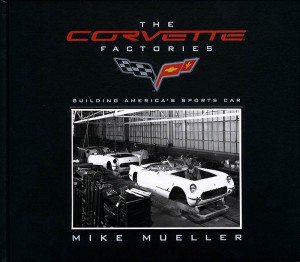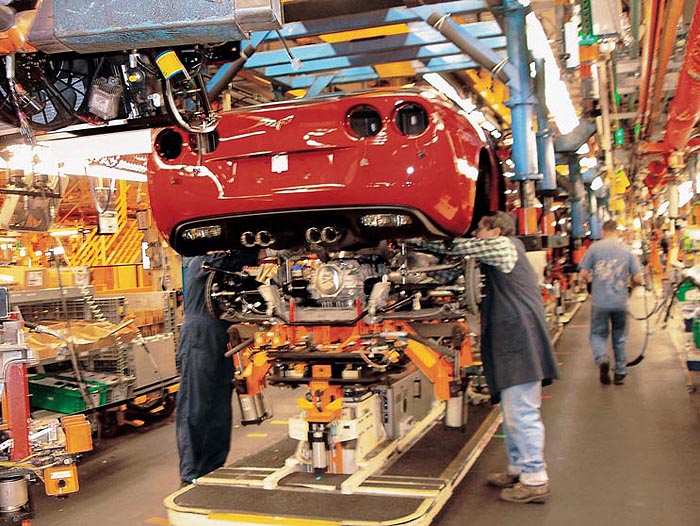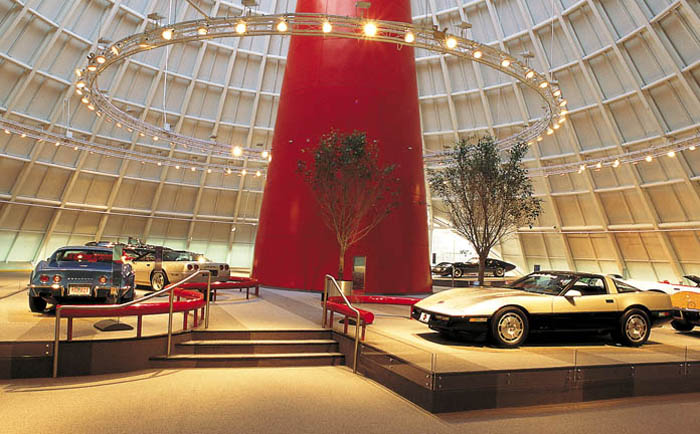
The Corvette Factories: Building America’s Sports Car by Mike Mueller, A Book Review
By K. Scott Teeters
Mike Mueller Gives the Tour and Shows Us How Corvettes Are Built
Until Chevrolet’s Bowling Green Assembly plant started offering the Corvette Museum Delivery option (RPO-R8C) most Corvette fans probably never thought they could actually see how Corvettes are built. What’s the assembly line like? What are the conditions inside the building? For most of us, you place your order for what you want on your Vette and it arrives. We all know that Corvettes aren’t hatched, they are made on an assembly lines, but the important part is taking delivery and driving!
Corvettes have always been unusual cars for many reasons. They were the first mass-produced American car to use fiberglass as a body material. And of course the unique and oftentimes, advanced technology involved in hardware that is expertly assembled and installed. Before Chevrolet started offering tours at the Bowling Green Assembly plant, the only way someone got to see how Corvettes were made was to get a job there.
Mike Mueller is one of the most prolific Corvette authors today. He has dozens of Corvette and other car books to his credit. In 2008 Mike started work on his latest Corvette book, “The Corvette Factories – Building America’s Sports Car” published by Motorbooks International (ISBN 978-0-7603-3551-2) Mike takes you on a factory tour from ‘53 to today.
This book is beautifully designed and the photos are a treat. You’ll be familiar with some of the images, but most are new to the public. There are pictures of the mahogany bucks for the first fiberglass bodies that were pure art. You also get the sense of how much hand labor goes into building a Corvette, or any other car for that matter. Think it’s easy work on an assembly line building cars? Think again.

The second chapter covers the St. Louis years from ‘54 to ‘81. The contrast between the earliest Corvettes and today’s car is astonishing. There are images of workers painting body parts without using respirator equipment. Things sure were different back them. This was the pre-robot era where every part was put together by a human being.
Chapter three “The New Kentucky Home” covers Corvette’s new state-of-the-art factory facility. Sub-assemblies are more complex. Electronic systems must be carefully checked. Most of the workers wear latex gloves and safety glasses. When Corvettes are being built, guided tours of the plant are available.

For new Corvette owners, Chapter 4 is a step-by-step guide to C6 Corvette production. The new cars are rolling electronic-mechanical marvels built to be thoroughbreds, capable of astonishing performance, built to last and weather the elements. You’ll see why the Corvette is a $50,000-plus automobile. And we shouldn’t forget that the Corvette’s cousin, the Cadillac XLR not only shares hardware with the C6, but it too was built at the Bowling Green Plant. Also, the 1,000,000th Corvette rolled off the Bowling Green line on July 2, 1992. When one stops and thinks about some of the astonishing Corvettes that were put together in this facility, it’s almost staggering. The C4 ZR-1’s, all the Pace Car Corvettes, the Grand Sports, the C5 and C6 Z06 cars, the C6 Grand Sports, and of course, the 200-mph C6 ZR1. If you soak in the images and story, you will come away with a whole new respect for the highly skilled, talented people that build production Corvettes. BRAVO to everyone that worked there and to those who are still on the job.

The final chapter is a literary, visual tour of The National Corvette Museum. The NCM is the final home of some of the most unique and special Corvettes ever made. On display are famous engines and racing Corvettes from the old days. Special, one-of-a-kind experimentals, prototypes, and show car Corvettes. Like all production cars, Corvettes are crash tested. On display is an early ‘90s yellow roadster with its front end smashed in. OUCH! There are chassis displays, models, Corvette art, dioramas, and life-size sculptures of famous Corvette people from the past. No other American marquee has such a facility.
This delightful book has something for every Corvette lover. For history buffs like me, the St. Louis days is a trip in a time machine. For fans of the newer C4 to C6 cars, you’ll get real insight into how your Corvette is built. Good job Mike! I’m looking forward to your next Corvette title. – KST
Available at Amazon:The Corvette Factories: Building America’s Sports Car
This article was written by K. Scott Teeters, a freelance columnist and artist with VETTE Magazine. His monthly column, “The Illustrated Corvette Series” has been running consecutively in VETTE since 1997 and can be found on the very last page of every issue. You can find reproductions of his Corvette art at: www.IllustratedCorvetteSeries.com. His book, The Illustrated Corvette Series by CarTech will be out late 2010.
